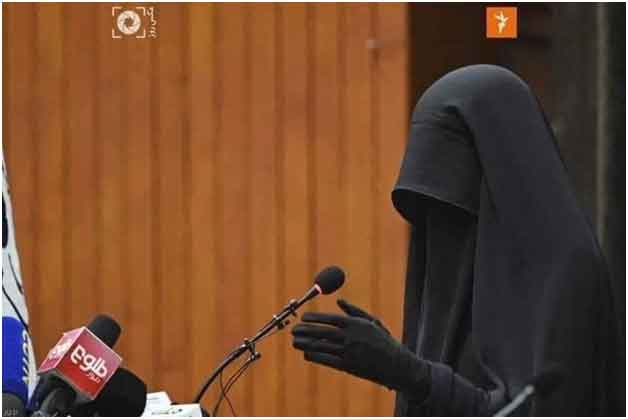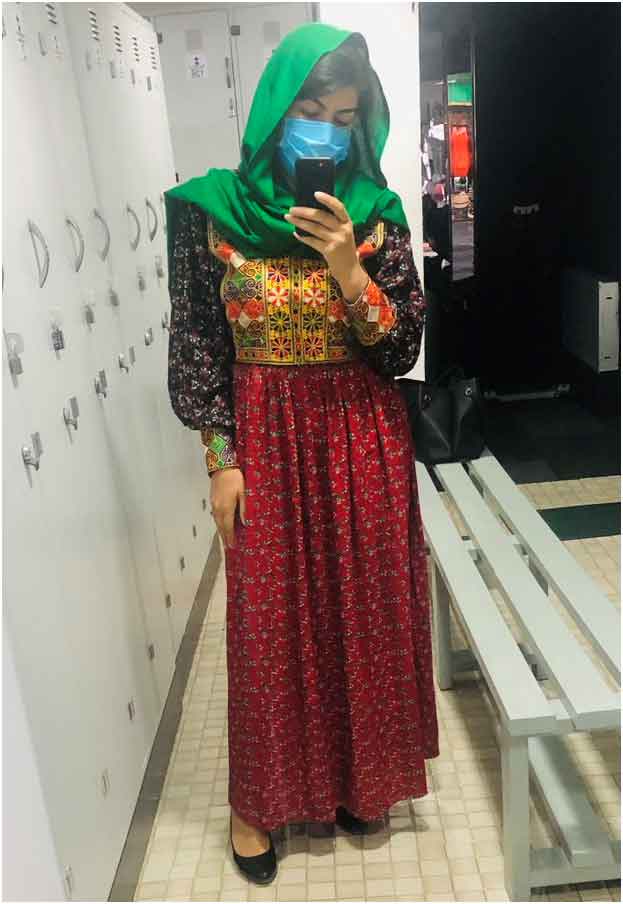
Fatima Kakkar, MD, MPH (@DrFatimaKakkar) wrote: Proudly wearing in our traditional, colourful, vibrant Afghan clothes #DoNotTouchMyClothes #AfghanWoman #AfghanistanCulture #AfganistanWomen
Afghan women are protesting Taliban imposed women dress code. At the same time, Taliban organized a head to toe veiled women gathering at the Shaheed Rabbani Education University in Kabul on September 11, 2021 attended by a few dozens of women claiming to be students. The Taliban follower veiled students held Taliban flags as they listened a speaker before the pro-Taliban rally at the university. The rally was guarded by the Talibans with rifles.
To protest a Taliban-mandated dress code that reportedly requires female students, teachers and school employees to cover up from head to toe and wear black in the classroom and on campuses, Afghan women around the world are sharing photos of themselves in much more colorful garb.
It is a social media-driven demonstration to show off another side of Afghan culture that the Taliban cannot so easily ignore, these women say.
Afghan women around the world are posting photos online dressed in bright and vibrant traditional garments – with captions like “This Is Afghanistan.”
The campaign is in response to footage of women inside Afghanistan dressed in black all-enveloping niqabs and gowns.
They were apparently demonstrating in support of the country’s new Taliban rulers at Kabul University.
Though many women said they believed the purported protest was staged.
And that several people dressed in the head-to-toe black burqa gowns were men.
The online campaign against this has been run by hashtags like #DoNotTouchMyClothes and #AfghanistanCulture
Twitter searches for “#AfghanistanCulture” and “#DoNotTouchMyClothes” brought up hundreds of images of women donning bright colors in bold patterns.

“This is Afghan culture. I am wearing a traditional Afghan dress,” Dr. Bahar Jalali wrote on Twitter to caption of photo of herself in a shiny green dress with colorful trim and flowery top. “I am wearing a traditional Afghan dress.”
Jalali, whose Twitter bio says she is a historian and “Founder of the First Gender Studies Program in Afghanistan,” also tweeted in response to a photo of a woman completely covered — including gloves on her hands — in all black.

“No woman has ever dressed like this in the history of Afghanistan,” she wrote. “This is utterly foreign and alien to Afghan culture. I posted my pic in the traditional Afghan dress to inform, educate, and dispel the misinformation that is being propagated by Taliban.”
According to CNN, the Twitter trend was sparked after a photo emerged of female students in all black waving Taliban flags in a classroom at a university in Kabul, the capital.

Fatima Murchal (@FMurchal) wrote: This is how we dress, period! #AfghanCulture
The Taliban’s capture of power last month prompted concerns that the regime would strip away freedoms of Afghans and especially women as they did from 1996 until 2001.
“Our women are Muslim. They will also be happy to be living within our frameworks of Sharia [Islamic law],” a Taliban spokesman said last month even as he insisted the group would be more moderate than feared.
This is how we dress, period!” Fatima Murchal wrote on Twitter alongside a selfie that shows her long, intricately designed dress in black, red, gold and a green head scarf.
Dr. Fatima Kakkar, whose Twitter bio says she resides in Montreal, shared a photo of nine women and girls in brilliant, bright dresses and wrote, “Proudly wearing in our traditional, colourful, vibrant Afghan clothes.”
“At the end of the day, it comes down to the ability to choose themselves what Afghan women get to wear that is being stripped away by being FORCED to adopt the black niqab as women’s clothing,” user @Deeebsters wrote as part of the #DoNotTouchMyClothes Twitter trend to show off gorgeously made, flowing gowns of bold colors.
“THIS is traditional Afghan clothing NOT the niqab.”
The Afghan women’s campaign gained momentum after Afghan historian Bahar Jalali, who is based in the U.S., tweeted criticizing the black garments worn by the demonstrators.
While the new Taliban regime has promised to allow women more freedoms, there have been reports of women being barred from going to work, and some being beaten in recent weeks for protesting Taliban rule. Reports also came out that women were bloodied by the Taliban beating the women, and a pregnant police officer was bloodied, face mutilated, and then shot dead in front of her husband and children.
Universities have installed curtains inside classrooms to segregate men and women.
But women across Afghanistan have staged several protests, demanding that the rights they won over the last two decades be preserved. The women’s protest marches were joined by hundreds of women.
Changes
A report by USA Today said on September 15, 2021:
Afghans left behind after the U.S. military withdrew wear their country’s changes.
They show up in the bruises left from a beating or the garb required for women who had adopted more modern dress but now must cover their bodies to comply with the Taliban.
“You can see the changes,” a woman who remains in Afghanistan told USA TODAY.
After making early promises about a more inclusive government, the Taliban have returned in some ways to the brutal regime that ruled the country before the American invasion in 2001.
Journalists have suffered beatings. The outgoing government’s ambassador to the UN has raised concerns about human rights violations in the last province where the Taliban are trying to win control.
Since the Taliban gained control of Kabul, several images depicting women outside beauty salons have been removed or covered up.
Afghans find themselves living in a country that has already radically changed and probably will change even further.
“What we are seeing is totally different from what they are saying,” the woman said of the Taliban.
Her changing country shows up in the mirror before she leaves for a trip to the grocery store. After years of wearing suits with light jackets, a pop of color in a blouse and a headscarf draped over her shoulders and under her chin, she now dons a borrowed black burqa that covers all but her face.
Even that, though, was too much, she said. A Taliban fighter flashed a gun, she said, when he told her that only her eyes could be visible.
“If you don’t follow what they are saying, they start beating,” she said. USA TODAY did not identify the woman and others who remain in Afghanistan because of concerns for their safety.
A country in crisis
The report said:
Life in communities that recently came under Taliban rule has been quickly and sharply upended as the extremist group reimposes strict conventions on the population.
Many of the social and economic gains cities like the capital, Kabul, saw over the past two decades have eroded in weeks. The country faces an economic crisis that threatens widespread famine and social collapse should it not be remedied.
Much of the landlocked country’s economy depends on imports. Foreign aid accounts for about 40% of the economy.
A United Nations report found that Afghanistan, where already nearly two-thirds of people live in poverty, is on the verge of universal impoverishment and economic collapse in the coming year. The study predicts the country’s economy will shrink 3.6% to 13.2% over the next fiscal year.
The UN said Monday that it has raised more than $1.2 billion to help 11 million Afghans as famine threatens to grip the country.
The new Taliban government is unable to access about $9 billion in frozen foreign currency reserves while international support from the U.S. and groups like the International Monetary Fund and World Bank has halted.
In the meantime, many Afghans are forced to wait days in line at banks to access accounts and are limited in how much cash they can withdraw.
Prices have continued rising, even amid the scarcity of cash. Afghans who spoke to USA TODAY said grocery prices have doubled and medicine is difficult to find.
The combination of rising prices and the inability to obtain money has made it challenging to meet even the most basic needs.
The woman who remains in Afghanistan said the Taliban have prevented women from working. Afghans are selling their possessions – rugs, curtains and dishes – at deep discounts to scrape together money to buy food, she said.
“This is like simply a jail, a jail with big square meters, but there is no one coming in and nobody coming out,” an Afghan man who remains in the country told USA TODAY.
Familiar faces take control of Kabul
The report added:
Since U.S. and allied forces withdrew from the country, the fundamentalist group has established an interim government headed by a Cabinet stacked with hard-line ministers. Many of the new leaders are veterans of the Taliban’s last government in the 1990s and early 2000s.
All the ministers are men, the overwhelming majority are from the dominant Pashtun ethnic group, and at least one, interior minister Sirajuddin Haqqani, is on the FBI’s Most Wanted list for a bounty of $5 million.
Though Taliban spokesmen swear the appointments are temporary, the group’s exclusion of women and ethnic and religious minorities, including the country’s sizeable Shiite Muslim population, already has alarmed the international community.
Human rights abuses under Taliban rule
The report said:
Taliban fighters are now going door to door in cities across the country, hunting Afghans who aided American and coalition forces, multiple sources told USA TODAY.
“They will be judging them on the spot,” said Samim Rahman Rahmani, an interpreter who evacuated Afghanistan. “That’s why I am worried about my friends that they left behind in Afghanistan with their families.”
Rahmani said he and his family are in Germany waiting for flights to the U.S. to resume after a measles outbreak, but he remains in contact with people in Afghanistan. They often change locations to evade the Taliban, he said.
Several Afghans told USA TODAY that even if they initially can conceal their identity, they fear being identified as having worked for American interests.
One Afghan man said he goes out only at night after being beaten with a stick by a Taliban fighter, and he moves his family to avoid staying in one place too long. They wear coverings to avoid detection.
“I couldn’t go to work and can’t find a job because I’m not in one place,” he told USA TODAY.
The worsening situation has caused backlash to Taliban rule in cities across the country.
On Tuesday, thousands took to the streets in Kandahar, Afghanistan’s second-largest city, after the Taliban began evictions in an area that is largely occupied by the families of retired army generals and other members of the Afghan security forces, according to Reuters.
Afghan media’s bleak future
Independent media in the country have been targeted for reporting on the unrest, including major anti-Taliban protests across the country.
Tolo News, the country’s first 24/7 channel, known for its hard-hitting reporting, has come under harassment from the Taliban for its early coverage of the incoming government. A cameraman covering protests in Kabul for the station was detained for three hours before being released, according to The Associated Press, and reporters elsewhere have been harassed by Taliban fighters.
Though the Taliban’s promises to preserve an open media environment already have proven false, some within the group see an opportunity in using Tolo and other coerced media as a way to manage their image domestically and abroad, according to a Financial Times report.
The effort to curb critical media is part of a larger strategy of brand management from the Taliban, who are determined to present a better face to the world than was evident during their past reign.
Taliban-supporting women waving banners reading “the women who left don’t represent us” accompanied by cheerful television newscasts announcing the group’s edicts reflect a bid for domestic support and a play to reassure foreign audiences that the situation on the ground is not dire.
Independent journalists in the country were not convinced.
In a column for USA TODAY, Afghan journalist Fatema Hosseini recounted how the Taliban brutalized and tortured her colleagues for reporting on their activities.
Hosseini, who recently fled, recounted how Taliban fighters blamed journalists reporting on protests for inciting backlash. Others have received separate death threats and been tortured for their coverage.
“Journalists in Afghanistan know they cannot hide what is happening, to them or their country. If they hide it, the Taliban will get more opportunities to abuse them. But spreading the news is also a huge risk of these people’s lives. Next time, if the Taliban see any of my five colleagues, they might be killed,” Hosseini wrote.
“The Taliban are already killing people and torturing them. It’s so easy for them. It’s just a matter of giving an order to them.”
New restrictions for women
Life under the new Taliban rule has been especially changed for women. In Kabul, which was a dynamic and diverse metropolis only this summer, women are again required to have male escorts in public.
The Taliban have reimposed gender divisions elsewhere in public life, especially in education, where many women fear they will be barred from attending any form of education and relegated to a reclusive life once more.
Women attending private Afghan universities must wear an abaya robe and niqab covering most of the face, the Taliban have ordered, and classes must be segregated by sex — or at least divided by a curtain.
Afghan women who spoke to USA TODAY expressed fear about the new reality.
Asila Wardak, a women’s rights activist in Afghanistan who is involved with Every Woman Treaty, said fear and panic have spread.
At checkpoints outside Kabul, women generally pass without search or acknowledgement, she said, but men who appear out of the ordinary are stopped. The country’s land borders continue to draw crowds of people trying to leave, she said.
Like other women, Wardak said she has started wearing a larger scarf to comply with the Taliban.
“For me personally, I cannot go to work. I don’t go to public places. I don’t visit any friends. I avoid crowded places,” she said.
She now leaves her home only to shop for food and wonders if she will ever return to her job as a professional diplomat. She survived for several days eating boiled chickpeas to avoid going out. While she has maintained a presence on social media, Wardak said activism has become more dangerous.
“We had the right to go to work. We had the right to speak up. We had the right to go alone on the streets. We had the right to wear whatever we want. We had the right to enjoy. We had enjoyment. We had good times,” another woman who remains in Afghanistan told USA TODAY. “There is no hope anymore.”
UN refugee chief warns ‘greater suffering’ likely in Afghanistan
A Reuters report said:
Afghanistan needs urgent and sustained support from the international community to prevent a larger humanitarian crisis, the head of the UN refugee agency said, warning of global implications if that were to happen.
“The humanitarian situation in Afghanistan remains desperate,” UN High Commissioner for Refugees Filippo Grandi said in a statement after a three-day visit to the South Asian nation.
“If public services and the economy collapse, we will see even greater suffering, instability, and displacement both within and outside the country,” he added in Wednesday’s statement.
“The international community must therefore engage with Afghanistan – and quickly – in order to prevent a much bigger humanitarian crisis that will have not only regional, but global implications.”
More than 3.5 million Afghans were already displaced in a country that is battling drought and the COVID-19 pandemic.
Poverty and hunger have spiralled since the Taliban takeover, and UN Secretary-General Antonio Guterres told an international aid conference this week that Afghans are facing “perhaps their most perilous hour”.
Donors at the conference pledged more than $1.1 billion to help Afghanistan.
Another report said:
During this three-day visit, U.N’s Filippo Grandi was shown around a warehouse filled with relief items. Trucks arrived from Pakistan with tents and other supplies for Afghan families, as food and medicine have been scarce.
Even before the Taliban took over last month, Grandi said in written statement, more than 18 million Afghans, or about half the population, required humanitarian aid.
IMF calls for action to prevent humanitarian crisis in Afghanistan
The international community should take urgent action to prevent a humanitarian crisis in Afghanistan, the IMF said Thursday.
With the country currently cut off from funding from the International Monetary Fund, the Washington-based crisis lender is worried about the fate of the people in Afghanistan, spokesman Gerry Rice told reporters.
“We stand ready to work with the international community to advocate for urgent actions to stall a looming humanitarian crisis,” Rice said.
Rice signaled the IMF favors “allowing the flow of remittances and small scale transfers” to Afghanistan.
But the IMF cannot resume direct engagement with Afghanistan “until there is clarity within the international community on the recognition of the government.”
“We’re deeply concerned with the difficult economic situation in Afghanistan and the humanitarian situation in Afghanistan and we’ve said, the immediate focus should indeed be on that humanitarian situation (and) aid to help the Afghan people.”
After the civilian government in Kabul fell swiftly to the Taliban, the IMF and World Bank suspended activities in the country, which meant withholding aid as well as $340 million in new reserves issued by the IMF last month.
And with Washington blocking access to much of the $9 billion in Afghan reserves held overseas, the country is facing a cash crunch.
‘A fantasy’ to think UN can fix Afghanistan, says Guterres
Asked in an interview with Reuters a month after the Taliban took control of Afghanistan from a Western-backed government whether he felt pressure to repair the country’s plight, Guterres said: “I think there is an expectation that is unfounded” of U.N. influence as the main international organization still on the ground there.
The United Nations will be doing everything it can for a country that Guterres said is on “the verge of a dramatic humanitarian disaster” and has decided to engage the Taliban in order to help Afghanistan’s roughly 36 million people.
Taliban say women can study at university but classes must be segregated
An earlier Reuters report said:
Women in Afghanistan will be allowed to study in universities as the country seeks to rebuild after decades of war but gender-segregation and Islamic dress code will be mandatory, the Taliban’s new Higher Education minister said on Sunday.
The minister, Abdul Baqi Haqqani, said the new Taliban government, named last week, would “start building the country on what exists today” and did not want to turn the clock back 20 years to when the movement was last in power.
He said female students would be taught by women wherever possible and classrooms would remain separated, in accordance with the movement’s interpretation of Islamic sharia law.
“Thanks to God we have a high number of women teachers. We will not face any problems in this. All efforts will be made to find and provide women teachers for female students,” he told a news conference in Kabul.
The issue of women’s education has been one of the central questions facing the Taliban as they seek to persuade the world that they have changed since the harsh fundamentalist rule they imposed in the 1990s when women were largely banned from studying or working outside the home.
Taliban officials have said women will be able to study and work in accordance with sharia law and local cultural traditions but strict dress rules will apply. Haqqani said hijab religious veils would be mandatory for all female students but did not specify if this meant headscarves or compulsory face coverings.
Haqqani said where no women teachers were available special measures would be adopted to ensure separation.
“When there is really a need, men can also teach (women) but in accordance with sharia, they should observe the veil,” he said. Classrooms would be curtained off to divide male and female students where necessary and teaching could also be done through streaming or closed circuit TV.
Classrooms divided by curtains have already been seen in many places since the Western-backed government collapse and the Taliban seized Kabul last month.
Haqqani told reporters that gender segregation would be enforced across Afghanistan and all subjects taught at colleges would also be reviewed in the coming months.
 RSS Feed
RSS Feed















 September 17th, 2021
September 17th, 2021  Awake Goy
Awake Goy  Posted in
Posted in  Tags:
Tags: 













